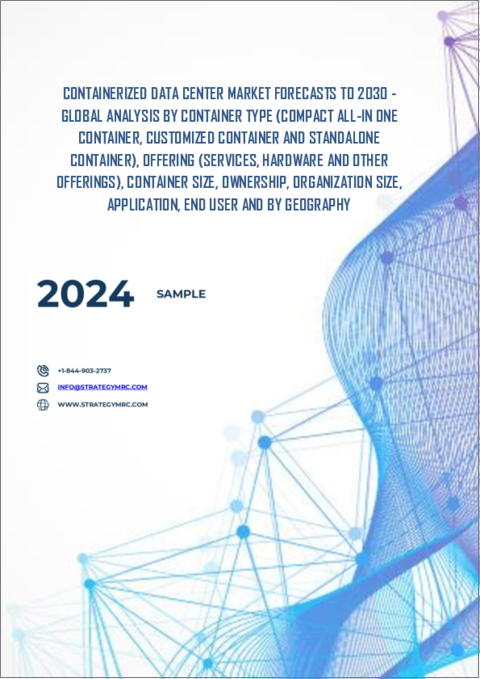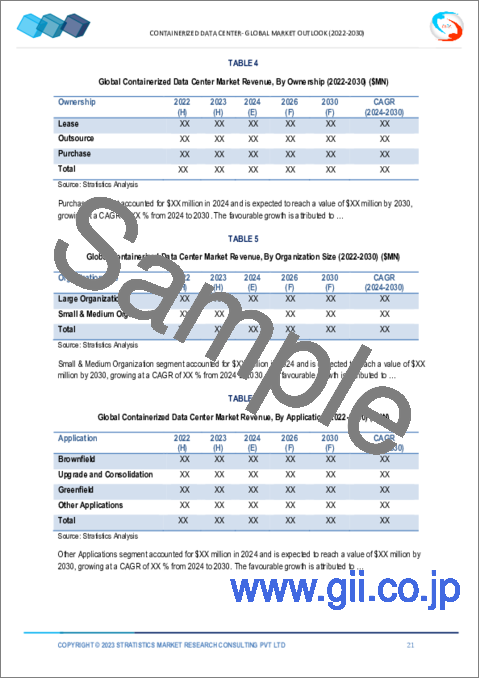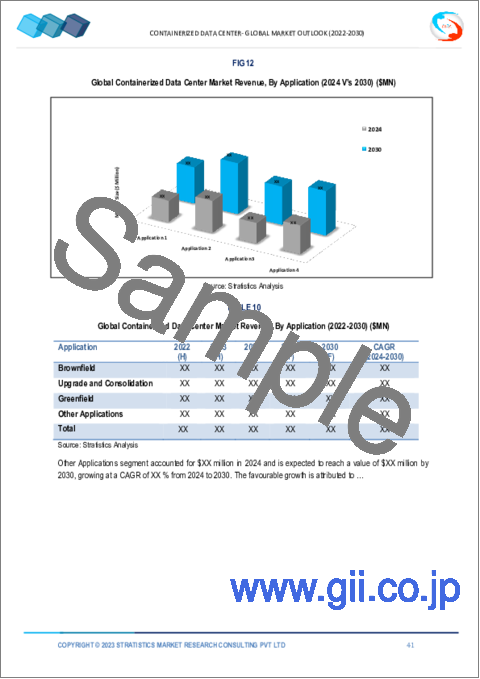|
|
市場調査レポート
商品コード
1446985
コンテナ型データセンター市場の2030年までの予測: コンテナタイプ、オファリング、コンテナサイズ、所有、組織規模、用途、エンドユーザー、地域別の世界分析Containerized Data Center Market Forecasts to 2030 - Global Analysis By Container Type, Offering, Container Size, Ownership, Organization Size, Application, End User and By Geography |
||||||
カスタマイズ可能
|
|||||||
| コンテナ型データセンター市場の2030年までの予測: コンテナタイプ、オファリング、コンテナサイズ、所有、組織規模、用途、エンドユーザー、地域別の世界分析 |
|
出版日: 2024年03月03日
発行: Stratistics Market Research Consulting
ページ情報: 英文 200+ Pages
納期: 2~3営業日
|
全表示
- 概要
- 図表
- 目次
Stratistics MRCによると、コンテナ型データセンターの世界市場は2023年に112億米ドルを占め、予測期間中のCAGRは20.8%で、2030年には420億米ドルに達する見込みです。
コンテナ型データセンターは、輸送用コンテナ内にサーバー、ストレージ、ネットワーク機器を収容するモジュラー型コンピューティング施設です。通常、標準化されたハードウェアとソフトウェア・コンポーネントが組み込まれているため、迅速な展開と既存インフラへの容易な統合が可能です。さらに、コンテナ型データセンターには、建設期間とコストの削減、エネルギー効率の向上、メンテナンスの簡素化などの利点があります。コンテナ型データセンターは、迅速な配備や一時的なコンピューティング・ニーズ、スペースやインフラ・リソースが限られた環境で特に有用です。
Cloud Infrastructure Report 2021に掲載された調査結果によると、回答者の57%がインフラの半分以上をクラウドで利用していると回答しており、64%は今後5年間で完全にパブリッククラウドを利用するようになると予想しています。
拡張性と柔軟性
コンテナ型データセンターは急成長への対応に優れており、企業は大幅なリードタイムや混乱なしにコンピューティング能力を拡張することができます。コンテナ化により、ITインフラはコンテナ・ユニットを追加または削除することで簡単にスケールアップまたはスケールダウンすることができ、リソースの割り当てにダイナミックで応答性の高いアプローチを提供し、これがこの市場をさらに牽引しています。
初期投資コスト
コンテナ型データセンターは、モジュラー・ユニットやその他の必要なコンポーネントを購入するために多額の初期投資を必要とします。これは、特に予算が限られていたり、財源に制約のある組織にとっては障壁となり得ます。さらに、コンテナ型データセンターのカスタマイズや既存のインフラとの統合にかかるコストも、初期投資の一因となります。初期投資コストに影響するもう一つの要因は、立地準備の必要性であり、これがこの市場の拡大を妨げています。
迅速な展開
コンテナ型データセンターは、重要なITインフラの導入に比類ないスピードと効率を提供するため、企業は厳しいスケジュールをこなし、変化するビジネスニーズに迅速に対応することができます。大規模な計画、建設、試運転プロセスを必要とする従来のデータセンターとは異なり、コンテナ型データセンターは数週間から数日で迅速に展開できます。さらに、このような柔軟性により、企業は新たな機会や課題に迅速に対応できるようになり、市場の成長を大きく後押ししています。
教育不足
利点や使用事例の理解が限られていることが、この教育不足の一面であり、コンテナ型データセンターを代替ソリューションとして検討することをためらわせる要因となっています。組織は、コンテナ型データセンターが提供できる迅速な展開、拡張性、エネルギー効率、費用対効果などのメリットを知らない可能性があります。さらに、教育リソースやトレーニング・プログラムが不足していることも多く、このような知識のギャップがコンテナ型データセンターの採用を妨げている可能性があります。
COVID-19の影響
COVID-19の大流行は、コンテナ型データセンター市場にいくつかの悪影響をもたらしました。世界・サプライチェーンの混乱は、コンテナ型データセンター・コンポーネントの製造と納入の遅れにつながり、プロジェクトの遅延と導入コストの増大を招いた。これはコンテナ型データセンター・ソリューションの需要に直接影響しており、特に財務的な制約に直面している中小企業が市場成長の妨げとなっています。
予測期間中はハードウェア・セグメントが最大になる見込み
ハードウェア・セグメントは、輸送用コンテナの限られたスペースとモジュール構造に適合するように特別に設計または適合され、コンパクトなフォームファクターで最適な性能と効率を保証することから、最大のシェアを占めると推定されます。これには、サーバーラック、ストレージシステム、ネットワーク機器、冷却システム、配電ユニット(PDU)、セキュリティ機構などが含まれ、このセグメントの成長を牽引しています。
ブラウンフィールド分野は予測期間中に最も高いCAGRが見込まれる
既存のインフラ課題を解決するためにコンテナ型ソリューションに注目する企業が増えていることから、ブラウンフィールド分野は予測期間中に最も高いCAGRを示すと予想されます。これらのソリューションは、大規模な改修や建設を必要とせずにデータセンターの容量を拡張またはアップグレードできる、コスト効率に優れた効率的な方法を提供します。さらに、このアプローチにより、企業は増大するデータ需要に対応してITインフラを拡張することができ、このセグメントの拡大を後押ししています。
地域別シェア
北米は、輸送用コンテナに収められたモジュール式データセンター・ソリューションの展開により、予測期間中に最大の市場シェアを獲得しました。デジタルサービス、クラウドコンピューティング、IoT技術の普及により、データストレージと処理能力に対する需要が増加しています。さらに、北米の堅牢なITインフラは、主要な市場プレーヤーや技術革新者の存在と相まって、同地域のコンテナ型データセンター市場の拡大をさらに加速させています。
CAGRが最も高い地域:
予測期間中、欧州のCAGRが最も高くなると予想されます。スケーラブルで柔軟なデータセンター・インフラに対する需要が高まっているため、欧州の企業や組織はIT運用を効率的に管理するためにコンテナ型データセンターに注目しています。さらに、一般データ保護規則(GDPR)など、データのプライバシーとセキュリティに関する厳しい規制により、欧州の企業はセキュリティ対策を強化したデータセンター・ソリューションの採用を余儀なくされており、これが同地域を後押ししています。
無料のカスタマイズサービス:
本レポートをご購読のお客様には、以下の無料カスタマイズオプションのいずれかをご利用いただけます:
- 企業プロファイル
- 追加市場プレーヤーの包括的プロファイリング(3社まで)
- 主要企業のSWOT分析(3社まで)
- 地域セグメンテーション
- 顧客の関心に応じた主要国の市場推計・予測・CAGR(注:フィージビリティチェックによる)
- 競合ベンチマーキング
- 製品ポートフォリオ、地理的プレゼンス、戦略的提携に基づく主要企業のベンチマーキング
目次
第1章 エグゼクティブサマリー
第2章 序文
- 概要
- ステークホルダー
- 調査範囲
- 調査手法
- データマイニング
- データ分析
- データ検証
- 調査アプローチ
- 調査ソース
- 1次調査ソース
- 2次調査ソース
- 前提条件
第3章 市場動向分析
- 促進要因
- 抑制要因
- 機会
- 脅威
- 用途分析
- エンドユーザー分析
- 新興市場
- 新型コロナウイルス感染症(COVID-19)の影響
第4章 ポーターのファイブフォース分析
- 供給企業の交渉力
- 買い手の交渉力
- 代替品の脅威
- 新規参入業者の脅威
- 競争企業間の敵対関係
第5章 世界のコンテナ型データセンター市場:コンテナタイプ別
- コンパクトオールインワンコンテナ
- カスタムコンテナ
- スタンドアロンコンテナ
第6章 世界のコンテナ型データセンター市場:オファリング別
- サービス
- ハードウェア
- その他の製品
第7章 世界のコンテナ型データセンター市場:コンテナサイズ別
- 20フィートコンテナ
- 40フィートコンテナ
- 60フィートコンテナ
第8章 世界のコンテナ型データセンター市場:所有別
- リース
- アウトソーシング
- 購入
第9章 世界のコンテナ型データセンター市場:組織規模別
- 大規模な組織
- 中小企業の組織
第10章 世界のコンテナ型データセンター市場:アプリケーション別
- ブラウンフィールド
- アップグレードと統合
- グリーンフィールド
- その他の用途
第11章 世界のコンテナ型データセンター市場:エンドユーザー別
- 銀行、金融サービス、保険(BFSI)
- ヘルスケア
- 政府
- IT&テレコム
- 小売とeコマース
- メディアとエンターテイメント
- 軍事と防衛
- 教育
- その他のエンドユーザー
第12章 世界のコンテナ型データセンター市場:地域別
- 北米
- 米国
- カナダ
- メキシコ
- 欧州
- ドイツ
- 英国
- イタリア
- フランス
- スペイン
- その他欧州
- アジア太平洋地域
- 日本
- 中国
- インド
- オーストラリア
- ニュージーランド
- 韓国
- その他アジア太平洋地域
- 南米
- アルゼンチン
- ブラジル
- チリ
- その他南米
- 中東とアフリカ
- サウジアラビア
- アラブ首長国連邦
- カタール
- 南アフリカ
- その他中東とアフリカ
第13章 主な発展
- 契約、パートナーシップ、コラボレーション、合弁事業
- 買収と合併
- 新製品の発売
- 事業拡大
- その他の主要戦略
第14章 企業プロファイル
- Emerson Network Power
- Cisco
- Huawei
- Dell
- HP
- Johnson Controls
- IBM
- Power Distribution Inc.(Pdi)
- Schneider Electric
- Soka Gakkai International(SGI)
List of Tables
- Table 1 Global Containerized Data Center Market Outlook, By Region (2021-2030) ($MN)
- Table 2 Global Containerized Data Center Market Outlook, By Container Type (2021-2030) ($MN)
- Table 3 Global Containerized Data Center Market Outlook, By Compact All-in One Container (2021-2030) ($MN)
- Table 4 Global Containerized Data Center Market Outlook, By Customized Container (2021-2030) ($MN)
- Table 5 Global Containerized Data Center Market Outlook, By Standalone Container (2021-2030) ($MN)
- Table 6 Global Containerized Data Center Market Outlook, By Offering (2021-2030) ($MN)
- Table 7 Global Containerized Data Center Market Outlook, By Services (2021-2030) ($MN)
- Table 8 Global Containerized Data Center Market Outlook, By Hardware (2021-2030) ($MN)
- Table 9 Global Containerized Data Center Market Outlook, By Other Offerings (2021-2030) ($MN)
- Table 10 Global Containerized Data Center Market Outlook, By Container Size (2021-2030) ($MN)
- Table 12 Global Containerized Data Center Market Outlook, By 20 Feet Container (2021-2030) ($MN)
- Table 12 Global Containerized Data Center Market Outlook, By 40 Feet Container (2021-2030) ($MN)
- Table 14 Global Containerized Data Center Market Outlook, By 60 Feet Container (2021-2030) ($MN)
- Table 14 Global Containerized Data Center Market Outlook, By Ownership (2021-2030) ($MN)
- Table 15 Global Containerized Data Center Market Outlook, By Lease (2021-2030) ($MN)
- Table 16 Global Containerized Data Center Market Outlook, By Outsource (2021-2030) ($MN)
- Table 17 Global Containerized Data Center Market Outlook, By Purchase (2021-2030) ($MN)
- Table 18 Global Containerized Data Center Market Outlook, By Organization Size (2021-2030) ($MN)
- Table 19 Global Containerized Data Center Market Outlook, By Large Organization (2021-2030) ($MN)
- Table 20 Global Containerized Data Center Market Outlook, By Small & Medium Organization (2021-2030) ($MN)
- Table 21 Global Containerized Data Center Market Outlook, By Application (2021-2030) ($MN)
- Table 22 Global Containerized Data Center Market Outlook, By Brownfield (2021-2030) ($MN)
- Table 23 Global Containerized Data Center Market Outlook, By Upgrade and Consolidation (2021-2030) ($MN)
- Table 24 Global Containerized Data Center Market Outlook, By Greenfield (2021-2030) ($MN)
- Table 25 Global Containerized Data Center Market Outlook, By Other Applications (2021-2030) ($MN)
- Table 26 Global Containerized Data Center Market Outlook, By End User (2021-2030) ($MN)
- Table 27 Global Containerized Data Center Market Outlook, By Banking, Financial Services and Insurance (BFSI) (2021-2030) ($MN)
- Table 28 Global Containerized Data Center Market Outlook, By Healthcare (2021-2030) ($MN)
- Table 29 Global Containerized Data Center Market Outlook, By Government (2021-2030) ($MN)
- Table 30 Global Containerized Data Center Market Outlook, By IT & Telecom (2021-2030) ($MN)
- Table 31 Global Containerized Data Center Market Outlook, By Retail & E-commerce (2021-2030) ($MN)
- Table 32 Global Containerized Data Center Market Outlook, By Media & Entertainment (2021-2030) ($MN)
- Table 33 Global Containerized Data Center Market Outlook, By Military & Defense (2021-2030) ($MN)
- Table 34 Global Containerized Data Center Market Outlook, By Education (2021-2030) ($MN)
- Table 35 Global Containerized Data Center Market Outlook, By Other End Users (2021-2030) ($MN)
Table Note: Tables for North America, Europe, APAC, South America, and Middle East & Africa Regions are also represented in the same manner as above.
According to Stratistics MRC, the Global Containerized Data Center Market is accounted for $11.2 billion in 2023 and is expected to reach $42.0 billion by 2030 growing at a CAGR of 20.8% during the forecast period. A containerized data center is a modular computing facility that houses servers, storage, and networking equipment within shipping containers. They typically incorporate standardized hardware and software components, enabling rapid deployment and easy integration into existing infrastructure. Moreover, containerized data centers offer advantages such as reduced construction time and cost, increased energy efficiency, and simplified maintenance. They are particularly useful in situations requiring quick deployment, temporary computing needs, or environments with limited space or infrastructure resources.
According to the survey results published in the Cloud Infrastructure Report 2021, 57% of the respondents reported that more than half of their infrastructure is in the cloud, while 64% expect that they will be fully in the public cloud in the next five years.
Market Dynamics:
Driver:
Scalability and flexibility
Containerized data centers excel at accommodating rapid growth, enabling businesses to expand their computing capacity without significant lead time or disruption. With containerization, IT infrastructure can be easily scaled up or down by adding or removing container units, providing a dynamic and responsive approach to resource allocation, which is driving this market further.
Restraint:
Initial investment costs
Containerized data centers require a considerable initial investment to purchase the modular units and other necessary components; this can be a barrier for organizations, particularly those with limited budgets or constrained financial resources. Additionally, the cost of customization and integration of containerized data centers with existing infrastructure can further contribute to the initial investment. Another factor influencing the initial investment costs is the need for site preparation, which is hampering this market expansion.
Opportunity:
Rapid deployment
These data centers offer unparalleled speed and efficiency in deploying critical IT infrastructure, enabling organizations to meet demanding timelines and quickly adapt to changing business needs. Unlike traditional data centers, which require extensive planning, construction, and commissioning processes, containerized data centers can be rapidly deployed within weeks or even days. Further, this flexibility ensures that businesses can quickly respond to emerging opportunities or challenges, thereby significantly propelling market growth.
Threat:
Lack of education
The limited understanding of the advantages and use cases is one aspect of this lack of education, which may lead to hesitancy in exploring containerized data centers as an alternative solution. Organizations may be unaware of the benefits, such as rapid deployment, scalability, energy efficiency, and cost-effectiveness that containerized data centers can offer. Furthermore, there is often a shortage of educational resources and training programs; this knowledge gap can hinder the adoption of containerized data centers.
Covid-19 Impact
The COVID-19 pandemic has presented several negative impacts on the containerized data center market. Disruptions in global supply chains have led to delays in the manufacturing and delivery of containerized data center components, causing project delays and increased costs for deployment. This has directly impacted the demand for containerized data center solutions, particularly among small and medium-sized enterprises facing financial constraints that are hindering market growth.
The hardware segment is expected to be the largest during the forecast period
The hardware segment is estimated to hold the largest share due to the fact that it is specifically designed or adapted to fit within the confined space and modular structure of shipping containers, ensuring optimal performance and efficiency in a compact form factor. This includes server racks, storage systems, networking equipment, cooling systems, power distribution units (PDUs), and security mechanisms that drive this segment's growth.
The brownfield segment is expected to have the highest CAGR during the forecast period
The brownfield segment is anticipated to have highest CAGR during the forecast period due to businesses increasingly turning to containerized solutions to address their existing infrastructure challenges. These solutions offer a cost-effective and efficient way to expand or upgrade their data center capacity without the need for extensive renovations or construction. Furthermore, this approach allows organizations to scale their IT infrastructure in response to growing data demands, which is boosting this segment's expansion.
Region with largest share:
North America commanded the largest market share during the extrapolated period owing to the deployment of modular data center solutions enclosed within shipping containers. The increasing demand for data storage and processing capabilities is fueled by the proliferation of digital services, cloud computing, and IoT technologies. Moreover, North America's robust IT infrastructure, coupled with the presence of key market players and technological innovators, further accelerates the expansion of the containerized data center market in the region.
Region with highest CAGR:
Europe is expected to witness highest CAGR over the projection period. Due to the increasing demand for scalable and flexible data center infrastructure, European businesses and organizations are turning to containerized data centers to efficiently manage their IT operations. Furthermore, stringent regulations regarding data privacy and security, such as the General Data Protection Regulation (GDPR), have compelled organizations in Europe to adopt data center solutions that provide enhanced security measures, which propelled this region.
Key players in the market
Some of the key players in the Containerized Data Center Market include Emerson Network Power, Cisco, Huawei, Dell, HP, Johnson Controls, IBM, Power Distribution Inc. (Pdi), Schneider Electric and Soka Gakkai International (SGI)
Key Developments:
In January 2024, The GSMA and IBM announced a new collaboration to support the adoption and skills of generative artificial intelligence (AI) in the telecom industry through the launch of GSMA Advance's AI Training program and the GSMA Foundry Generative AI program.
In December 2023, Dell Technologies Inc. announced that Dell Inc., its wholly-owned subsidiary has commenced cash tender offers for up to $500.0 million aggregate principal amount of the debt securities listed in the table below and subject to the Tender Sub-Caps.
In December 2023, IBM announced that it has entered into a definitive agreement with Software AG a company majority owned by Silver Lake, to purchase StreamSets and webMethods, Software AG's Super iPaaS (integration platform-as-a-service) enterprise technology platforms, for €2.13 billion in cash.
In May 2023, Dell Technologies and NVIDIA announce a joint initiative to make it easier for businesses to build and use generative AI models on premises to quickly and securely deliver better customer service, market intelligence, enterprise search, and a range of other capabilities.
Container Types Covered:
- Compact All-in One Container
- Customized Container
- Standalone Container
Offerings Covered:
- Services
- Hardware
- Other Offerings
Container Size Covered:
- 20 Feet Container
- 40 Feet Container
- 60 Feet Container
Ownerships Covered:
- Lease
- Outsource
- Purchase
Organization Size Covered:
- Large Organization
- Small & Medium Organization
Applications Covered:
- Brownfield
- Upgrade and Consolidation
- Greenfield
- Other Applications
End Users Covered:
- Banking, Financial Services and Insurance (BFSI)
- Healthcare
- Government
- IT & Telecom
- Retail & E-commerce
- Media & Entertainment
- Military & Defense
- Education
- Other End Users
Regions Covered:
- North America
- US
- Canada
- Mexico
- Europe
- Germany
- UK
- Italy
- France
- Spain
- Rest of Europe
- Asia Pacific
- Japan
- China
- India
- Australia
- New Zealand
- South Korea
- Rest of Asia Pacific
- South America
- Argentina
- Brazil
- Chile
- Rest of South America
- Middle East & Africa
- Saudi Arabia
- UAE
- Qatar
- South Africa
- Rest of Middle East & Africa
What our report offers:
- Market share assessments for the regional and country-level segments
- Strategic recommendations for the new entrants
- Covers Market data for the years 2021, 2022, 2023, 2026, and 2030
- Market Trends (Drivers, Constraints, Opportunities, Threats, Challenges, Investment Opportunities, and recommendations)
- Strategic recommendations in key business segments based on the market estimations
- Competitive landscaping mapping the key common trends
- Company profiling with detailed strategies, financials, and recent developments
- Supply chain trends mapping the latest technological advancements
Free Customization Offerings:
All the customers of this report will be entitled to receive one of the following free customization options:
- Company Profiling
- Comprehensive profiling of additional market players (up to 3)
- SWOT Analysis of key players (up to 3)
- Regional Segmentation
- Market estimations, Forecasts and CAGR of any prominent country as per the client's interest (Note: Depends on feasibility check)
- Competitive Benchmarking
- Benchmarking of key players based on product portfolio, geographical presence, and strategic alliances
Table of Contents
1 Executive Summary
2 Preface
- 2.1 Abstract
- 2.2 Stake Holders
- 2.3 Research Scope
- 2.4 Research Methodology
- 2.4.1 Data Mining
- 2.4.2 Data Analysis
- 2.4.3 Data Validation
- 2.4.4 Research Approach
- 2.5 Research Sources
- 2.5.1 Primary Research Sources
- 2.5.2 Secondary Research Sources
- 2.5.3 Assumptions
3 Market Trend Analysis
- 3.1 Introduction
- 3.2 Drivers
- 3.3 Restraints
- 3.4 Opportunities
- 3.5 Threats
- 3.6 Application Analysis
- 3.7 End User Analysis
- 3.8 Emerging Markets
- 3.9 Impact of Covid-19
4 Porters Five Force Analysis
- 4.1 Bargaining power of suppliers
- 4.2 Bargaining power of buyers
- 4.3 Threat of substitutes
- 4.4 Threat of new entrants
- 4.5 Competitive rivalry
5 Global Containerized Data Center Market, By Container Type
- 5.1 Introduction
- 5.2 Compact All-in One Container
- 5.3 Customized Container
- 5.4 Standalone Container
6 Global Containerized Data Center Market, By Offering
- 6.1 Introduction
- 6.2 Services
- 6.3 Hardware
- 6.4 Other Offerings
7 Global Containerized Data Center Market, By Container Size
- 7.1 Introduction
- 7.2 20 Feet Container
- 7.3 40 Feet Container
- 7.4 60 Feet Container
8 Global Containerized Data Center Market, By Ownership
- 8.1 Introduction
- 8.2 Lease
- 8.3 Outsource
- 8.4 Purchase
9 Global Containerized Data Center Market, By Organization Size
- 9.1 Introduction
- 9.2 Large Organization
- 9.3 Small & Medium Organization
10 Global Containerized Data Center Market, By Application
- 10.1 Introduction
- 10.2 Brownfield
- 10.3 Upgrade and Consolidation
- 10.4 Greenfield
- 10.5 Other Applications
11 Global Containerized Data Center Market, By End User
- 11.1 Introduction
- 11.2 Banking, Financial Services and Insurance (BFSI)
- 11.3 Healthcare
- 11.4 Government
- 11.5 IT & Telecom
- 11.6 Retail & E-commerce
- 11.7 Media & Entertainment
- 11.8 Military & Defense
- 11.9 Education
- 11.10 Other End Users
12 Global Containerized Data Center Market, By Geography
- 12.1 Introduction
- 12.2 North America
- 12.2.1 US
- 12.2.2 Canada
- 12.2.3 Mexico
- 12.3 Europe
- 12.3.1 Germany
- 12.3.2 UK
- 12.3.3 Italy
- 12.3.4 France
- 12.3.5 Spain
- 12.3.6 Rest of Europe
- 12.4 Asia Pacific
- 12.4.1 Japan
- 12.4.2 China
- 12.4.3 India
- 12.4.4 Australia
- 12.4.5 New Zealand
- 12.4.6 South Korea
- 12.4.7 Rest of Asia Pacific
- 12.5 South America
- 12.5.1 Argentina
- 12.5.2 Brazil
- 12.5.3 Chile
- 12.5.4 Rest of South America
- 12.6 Middle East & Africa
- 12.6.1 Saudi Arabia
- 12.6.2 UAE
- 12.6.3 Qatar
- 12.6.4 South Africa
- 12.6.5 Rest of Middle East & Africa
13 Key Developments
- 13.1 Agreements, Partnerships, Collaborations and Joint Ventures
- 13.2 Acquisitions & Mergers
- 13.3 New Product Launch
- 13.4 Expansions
- 13.5 Other Key Strategies
14 Company Profiling
- 14.1 Emerson Network Power
- 14.2 Cisco
- 14.3 Huawei
- 14.4 Dell
- 14.5 HP
- 14.6 Johnson Controls
- 14.7 IBM
- 14.8 Power Distribution Inc. (Pdi)
- 14.9 Schneider Electric
- 14.10 Soka Gakkai International (SGI)






